
How 3 Key Dehumidification Terms Relate
What is evaporation, condensation and dew point?
What are the relationships between these concepts?
Learn more in our Application Notes and Technical Bulletins:
Ventilation Air For Indoor Pools
Interaction of Pool Water and Air Chemistry
Swimming Pool Load Calculations
Read A Guide to an Integrated HVAC System Design for the 21st Century
Gated Content
Please fill out the form for access.
What is evaporation, condensation and dew point?
Evaporation
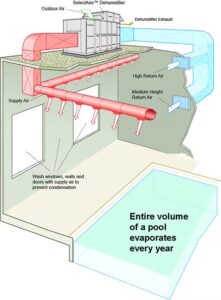 Evaporation is simply the process of conversion of liquid water into vapor. Evaporation is a continuous process that occurs constantly outdoors in the lakes and ponds and is the reason why it rains. Evaporation is caused by the absorbance of heat from a source that will allow the conversion from a liquid to a vapor escaping a body of water. As pool water evaporates, it cools the pool water and the air in the pool room. Almost 85 percent of the heat loss of a pool is from the evaporative effect. The remaining heat loss is through the walls and the floors of a pool room.
Evaporation is simply the process of conversion of liquid water into vapor. Evaporation is a continuous process that occurs constantly outdoors in the lakes and ponds and is the reason why it rains. Evaporation is caused by the absorbance of heat from a source that will allow the conversion from a liquid to a vapor escaping a body of water. As pool water evaporates, it cools the pool water and the air in the pool room. Almost 85 percent of the heat loss of a pool is from the evaporative effect. The remaining heat loss is through the walls and the floors of a pool room.
Condensation and Dew Point
The reverse function of evaporation is condensation when moist air passes over a cold surface and the water condenses when it reaches its dew point temperature at the cold surface.
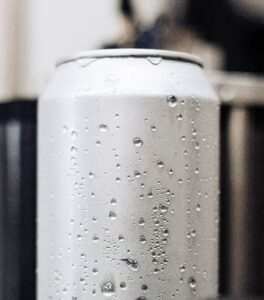
For example, if a cold beer can is removed from a refrigerator and set in a warm, moist room or outdoors in summer, within a few minutes water droplets start dripping down the outside of the can. As warm air touches the cold beer can, the air layer right at the surface of a cold beer can is actually cooling the air. The cold temperature from the beer can converts or condenses the water from air into liquid to form into beads of water or sweat on the side of the cold can. Air can only hold so much moisture, as a function of the air temperature. Warmer temperatures can hold more water vapor. Colder temperatures can’t hold as much water vapor which condenses into water droplets at the dew point, the point that the air is saturated at 100% relative humidity.
What are the relationships between these concepts & what can a dehumidifier do to control a pool room environment?
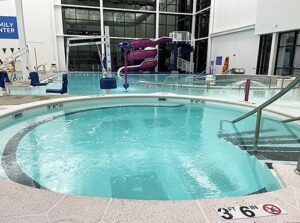 Ideally a pool room environment should be maintained at 50-60% relative humidity with air temperature in the mid-80s. That’s comfortable for a pool room where occupants wearing a swim suit or a t-shirt and shorts. Someone sitting next to the pool wearing a long shirt and pants would feel hot, humid and uncomfortable. So by its very environment, a pool room is on the high side of the comfort zone.
Ideally a pool room environment should be maintained at 50-60% relative humidity with air temperature in the mid-80s. That’s comfortable for a pool room where occupants wearing a swim suit or a t-shirt and shorts. Someone sitting next to the pool wearing a long shirt and pants would feel hot, humid and uncomfortable. So by its very environment, a pool room is on the high side of the comfort zone.
Controlling Dew Point
Dew point is very critical in establishing the actual evaporation rate from a pool and controlling it with a dehumidifier. A dehumidifier creates a cold surface using a coil (that is usually colder than a beer can) to condense the moisture out of the air to remove it from the pool room air. The liquid condensate is drained from the dehumidifier that delivers drier air back to the pool area. The dehumidifier is balancing the evaporative effect of the water from the pool, removing moisture from the air to maintain a dew point. If the dehumidifier is sized properly, it matches the load or the amount of water that evaporates into the air.
As pool water evaporates and a dehumidifier removes that moisture from the air, the air cools. For this reason, Desert Aire dehumidifiers have a hot gas reheat coil that heats the air before returning it to the pool room.
Summary
Evaporation is water vapor that leaves the pool into the air. Condensation occurs when moist air passes over a cold surface and the water condenses from the air at a dew point temperature. A dehumidifier mechanically condenses a portion of the moisture in the air on cold coils within it, like a cold beer can getting wet from condensation. It maintains the room’s relative humidity between 50% and 60% by controlling the dew point so that the pool room feels comfortable to the occupants. Desert Aire dehumidifier’s refrigeration cycle removes moisture and heat from that air and reclaims it to use to reheat the air to deliver it back to the pool room to maintain the temperature in the room.
Washing Windows
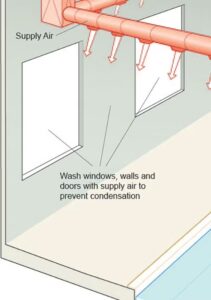
In well-designed pool rooms, the air supplied to the pool room is directed to “wash the windows” with air. Why? Windows are always going to be the weakest part of the building as they have the least insulating properties. Whether a single pane double pane or triple pane, window glass is much colder than a pool facility wall that has insulation and still the coldest surface in a pool room.
For this reason ductwork is designed so that a certain volume of air is directed to flush the windows. That actually creates a microclimate at the window surface. That the warm dry flushing air, even if the window is below the dew point of the main pool room, provides a buffer that is actually at a lower dew point. That microclimate prevents condensation on pool room windows.
How much moisture evaporates from an indoor pool?
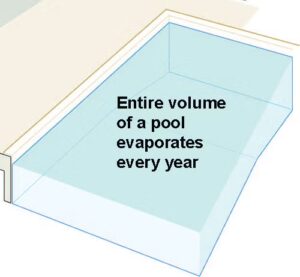
The entire volume of the pool every year. The amount of pool water evaporation can be calculated, converted to gallons, and compared to the volume of the pool water.
A hotel pool that isn’t very deep will evaporate its volume in a year. If a pool is really deep or has a huge diving well it might not evaporate quite as much volume, but a lot of water per year is leaving the pool.
This blog was edited from a transcript of a video interview (https://www.youtube.com/watch?v=4eaws3D8HPs&t=106s) of Desert Aire President Keith Coursin by Eric Knight of Orenda Technologies on the Natatorium Knowledge YouTube channel.
Find a Desert Aire Sales Rep Near You!
Our network of independent representatives are fully trained on Desert Aire’s dehumidification and DOAS solutions and can assist you in designing and sizing your engineered solutions.

